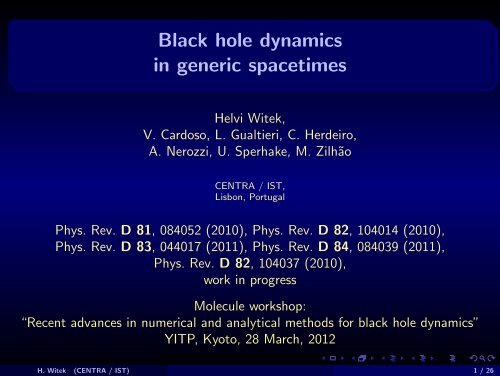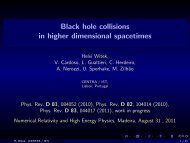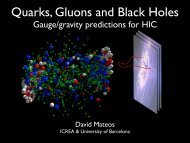Black hole dynamics in generic spacetimes
Black hole dynamics in generic spacetimes
Black hole dynamics in generic spacetimes
- No tags were found...
You also want an ePaper? Increase the reach of your titles
YUMPU automatically turns print PDFs into web optimized ePapers that Google loves.
<strong>Black</strong> <strong>hole</strong> <strong>dynamics</strong><strong>in</strong> <strong>generic</strong> <strong>spacetimes</strong>Helvi Witek,V. Cardoso, L. Gualtieri, C. Herdeiro,A. Nerozzi, U. Sperhake, M. ZilhãoCENTRA / IST,Lisbon, PortugalPhys. Rev. D 81, 084052 (2010), Phys. Rev. D 82, 104014 (2010),Phys. Rev. D 83, 044017 (2011), Phys. Rev. D 84, 084039 (2011),Phys. Rev. D 82, 104037 (2010),work <strong>in</strong> progressMolecule workshop:“Recent advances <strong>in</strong> numerical and analytical methods for black <strong>hole</strong> <strong>dynamics</strong>”YITP, Kyoto, 28 March, 2012H. Witek (CENTRA / IST) 1 / 26
Outl<strong>in</strong>e1 Collisions of black <strong>hole</strong>s <strong>in</strong> higher dimensional <strong>spacetimes</strong>2 <strong>Black</strong> <strong>hole</strong>s <strong>in</strong> a box3 Conclusions and OutlookH. Witek (CENTRA / IST) 2 / 26
<strong>Black</strong> <strong>hole</strong> collisions<strong>in</strong> higher dimensional <strong>spacetimes</strong>H. Witek (CENTRA / IST) 3 / 26
High Energy Collision of ParticlesConsider particle collsions with E = 2γm 0 c 2 > M PlHoop - Conjecture (Thorne ’72)⇒ BH formation, if circumference ofparticle < 2πr SCollisions of shock waves(Penrose ’74, Eardley & Gidd<strong>in</strong>gs ’02)⇒ BH formation if b ≤ r Snumerical evidence <strong>in</strong> ultra relativisticcollision of boson stars⇒ BH formation if boost γ c ≥ 2.9Low Lorentz boost, γ = 1Large Lorentz boost, γ = 4Choptuik & Pretorius ’10⇒ black <strong>hole</strong> formation <strong>in</strong> high energy collisions of particleshigher dimensional theories of gravity ⇒ TeV gravity scenariossignatures of black <strong>hole</strong> production <strong>in</strong> high energy collision of particlesat the Large Hadron Collider<strong>in</strong> ultra-high relativistic Cosmic rays <strong>in</strong>teractions with the atmosphereH. Witek (CENTRA / IST) 4 / 26
Life cycle of M<strong>in</strong>i <strong>Black</strong> Holes1 Formationlower bound on BH mass from area theorem (Yosh<strong>in</strong>o & Nambu ’02)2 Bald<strong>in</strong>g phase: end state is Myers-Perry black <strong>hole</strong>3 Sp<strong>in</strong>down phase: loss of angular momentum and mass4 Schwarzschild phase: decay via Hawk<strong>in</strong>g radiation5 Planck phase: M ∼ M PlGoal: more precise understand<strong>in</strong>g of black <strong>hole</strong> formation⇒ compute energy and angular momentum loss <strong>in</strong> gravitational radiationToy model: black <strong>hole</strong> collisions <strong>in</strong> higher dimensionsH. Witek (CENTRA / IST) 5 / 26
Numerical Relativity<strong>in</strong> D > 4 DimensionsYosh<strong>in</strong>o & Shibata, Phys. Rev. D80, 2009,Shibata & Yosh<strong>in</strong>o, Phys. Rev. D81, 2010Okawa, Nakao & Shibata, Phys. Rev. 83, 2011Lehner & Pretorius, Phys. Rev. Lett. 105, 2010Sork<strong>in</strong> & Choptuik, GRG 42, 2010; Sork<strong>in</strong>, Phys. Rev. D81, 2010Zilhão et al., Phys. Rev. D81, 2010, Witek et al, Phys. Rev. D82, 2010,Witek et al, Phys. Rev. D83, 2011, Zilhão et al., Phys. Rev. D84, 2011.H. Witek (CENTRA / IST) 6 / 26
Numerical Relativity <strong>in</strong> D Dimensionsconsider highly symmetric problemsdimensional reduction by isometry on a (D-4)-spheregeneral metric elementds 2 = g µν dx µ dx ν + λ(x µ )dΩ D−4H. Witek (CENTRA / IST) 7 / 26
Formulation of EEs as Cauchy Problem <strong>in</strong> D > 43+1 split of spacetime (4) M = R + (3) Σ (Arnowitt, Deser, Misner ’62)ds 2 = g µν dx µ dx ν = ( −α 2 + β k β k) dt 2 + 2β i dx i dt + γ ij dx i dx j3+1 split of 4D E<strong>in</strong>ste<strong>in</strong> equations with source terms=⇒ Formulation as <strong>in</strong>itial value problem with constra<strong>in</strong>ts (York 1979)Evolution Equations∂ t γ ij = −2αK ij + L β γ ij( )∂ t K ij = −D i D j α + α (3)R ij − 2K il Kj l + KK ij + L β K ij−α D − 4 (D i D j λ − 2K ij K λ − 1 )2λ2λ ∂ iλ∂ j λ∂ t λ = −2αK λ + L β λ∂ t K λ = − 1 (2 ∂l α∂ l λ + α (D − 5) + KK λ + D − 6λK λ2− D − 64λ∂l λ∂ l λ − 1 )2 Dl D l λ + L β K λH. Witek (CENTRA / IST) 9 / 26
Wave Extraction <strong>in</strong> D > 4Generalization of Regge-Wheeler-Zerilli formalism by Kodama & Ishibashi ’03Master functionΦ ,t = (D − 2)r (D−4)/2Energy flux & radiated energy2rF ,t − F r tk 2 − D + 2 + (D−2)(D−1)2, k = l(l + D − 3)r D−3Sr D−3dE ldt = (D − 3)k2 (k 2 − D + 2)(Φ l32π(D − 2),t) 2 , E =∞∑l=2∫ ∞−∞dt dE ldtMomentum flux & recoil velocitydP idt∫= dΩ d 2 ES ∞dtdΩ ni , v recoil =∣∫ ∞−∞dt dPdt∣H. Witek (CENTRA / IST) 10 / 26
Numerical Setupuse Sperhake’s extended Lean code (Sperhake ’07, Zilhão et al ’10)3+1 E<strong>in</strong>ste<strong>in</strong> equations with scalar fieldBaumgarte-Shapiro-Shibata-Nakamura formulation with mov<strong>in</strong>g puncturesdynamical variables: χ, ˜γ ij , K, à ij , ˜Γ i , ζ, K ζmodified puncture gauge∂ tα = β k ∂ k α − 2α(K + (D − 4)K ζ )∂ tβ i = β k ∂ k β i − η β β i + η Γ˜Γ i D − 4+ η λ ˜γ ij ∂ j ζ2ζmeasure lengths <strong>in</strong> terms of r S withr D−3 16πS=M(D − 2)A SD−2H. Witek (CENTRA / IST) 11 / 26
Equal mass head-on <strong>in</strong> D = 4, 5, 6Brill-L<strong>in</strong>dquist type <strong>in</strong>itial dataψ = 1 + r D−3 D−3S,1/4r1 + r D−3S,2D−3/4r2Key (technical) issues:modification of gaugeconditionsmodification of formulation<strong>in</strong>crease <strong>in</strong> E/M with D⇒ qualitative agreement withPP calculations(Berti et al, 2010)D r S ω(l = 2) E/M(%)4 0.7473 − i 0.1779 0.0555 0.9477 − i 0.2561 0.0896 1.140 − i 0.304 0.104H. Witek (CENTRA / IST) 12 / 26
Unequal mass head-on <strong>in</strong> D = 5consider mass ratios q = r D−3 D−3S,1/rS,2 = 1, 1/2, 1/3, 1/4Modes of Φ ,tE/M ∼ η 2 (M.Lemos ’10, MSc thesis)l=3 1/2 l=2 1/2Φ Φ ,t / rS ,t / rS0.0400.00500.00090Φ ,tl=4 / rS1/2q = 1q = 1:2q = 1:4-10 0 10 20 30∆t / r Sfitt<strong>in</strong>g functionEMη= 0.0164 − 0.0336η 22with<strong>in</strong> < 1% agreement with po<strong>in</strong>t particle calculation (Berti et al, 2010)H. Witek (CENTRA / IST) 13 / 26
Initial data for boosted BHs <strong>in</strong> D > 4construct <strong>in</strong>itial data by solv<strong>in</strong>g the constra<strong>in</strong>tsassumption: ¯γ ab = ψ 4D−3 δab , ¯K = 0 , ¯K ab = ψ −2  abconstra<strong>in</strong>t equations∂ a  ab D − 3 3D−5= 0 , ˆ△ψ + ψ− D−3  ab  ab = 0 , with4(D − 2) ˆ△ ≡ ∂ a ∂ aanalytic ansatz for  ab → generalization of Bowen-York type <strong>in</strong>itial dataelliptic equation for ψ → puncture method (Brandt & Brügmann ’97)ψ =1 + ∑ ir D−3 D−3S(i)/4r(i)+ u⇒ Hamiltonian constra<strong>in</strong>t becomesˆ△u + D − 34(D − 2)Âab  ab ψ − 3D−5D−3 = 0H. Witek (CENTRA / IST) 14 / 26
Head-on of boosted BHs (prelim<strong>in</strong>ary results)evolution of puncture with z/r S = ±30.185 with P/r D−3S= 0.4l = 2 mode of Φ ,tPP calculations (Berti et al, 2010)Φ, tl=20.040.030.020.010-0.01-0.02-0.03-0.04Issues:D = 5D = 6-0.050 50 100 150 200 250t / r Sdependence of radiated energy on D and boostlong-term stable evolutions for larger boostsadjustment of (numerical) gaugerequirement of very high resolution <strong>in</strong> wavezone for reasonable accuracyH. Witek (CENTRA / IST) 15 / 26
<strong>Black</strong> <strong>hole</strong> b<strong>in</strong>aries<strong>in</strong> a boxH. Witek (CENTRA / IST) 16 / 26
AdS / CFT correspondence (Maldacena ’97)Anti-de Sitter spacetime⇒ spacetime with negative cosmologicalconstantduality betweentheory with gravity on AdS d × X⇕conformal field theory on conformalboundaryconsider scalar field propagation <strong>in</strong> SAdSbackgroundd 2dr 2 ∗ψ + (ω 2 − V )ψ = 0potential V −→ ∞ as r −→ ∞⇒ view AdS as boxed spacetime⇒ toy model: BH evolution <strong>in</strong> a box Berti, Cardoso & Star<strong>in</strong>ets ’09H. Witek (CENTRA / IST) 17 / 26
<strong>Black</strong> Hole stabilitysuperradiant scatter<strong>in</strong>g of rotat<strong>in</strong>g BH (Penrose ’69, Christodoulou ’70,Misner ’72)imp<strong>in</strong>g<strong>in</strong>g wave amplified as it scatters off a BH if ω < mΩ Hextraction of energy and angular momentum of the BH by superradiant modes“black <strong>hole</strong> bomb” (Press & Teukolsky ’72)consider Kerr BH surrounded by a mirrorsubsequent amplification of superradiant modesstability of Kerr-AdS BHs (Hawk<strong>in</strong>g & Reall ’99, Cardoso et al. ’04)AdS <strong>in</strong>f<strong>in</strong>ity behaves as box ⇒ amplification of superradiant <strong>in</strong>stabilities?large Kerr-AdS BH: stablesmall Kerr-AdS BH: unstableH. Witek (CENTRA / IST) 18 / 26
BBHs <strong>in</strong> a Box - Setupmimic AdS-BH spacetime by BHs <strong>in</strong> a boximpose reflect<strong>in</strong>g b.c. via∂ t K ij = 0 and ∂ t γ ij = 0 at boundarywave extraction: Newman Penrose scalarsΨ 4 (outgo<strong>in</strong>g) and Ψ 0 (<strong>in</strong>go<strong>in</strong>g)<strong>in</strong>itial data: non-sp<strong>in</strong>n<strong>in</strong>g, equal mass BHshead-on collision ⇒ non-sp<strong>in</strong>n<strong>in</strong>g f<strong>in</strong>al BHquasi-circular <strong>in</strong>spiral ⇒ sp<strong>in</strong>n<strong>in</strong>g f<strong>in</strong>al BH witha/M = 0.69MovieG 0 1X X X X X X XrOuterBoundaryX X XX XX X XX XX XX XrijkX XX XX G 1 X1X XX XrOuterXXXRX G 2 G 3 G 2 X1 1G 3 2 2 XXXXXX XXX XX XX XX X XX XXX XX XX XX X XX X X X X X XH. Witek (CENTRA / IST) 19 / 26
BBHs <strong>in</strong> a Box - WaveformsR(Ψ 4 22 ) and R(Ψ0 22 )of first outgo<strong>in</strong>g pulse0.40.080.06rM Re[ψ 0 (t / M - 10)]22spectrumrM Re[ψ 4 (t / M)] 220.3Mω c = 0.4rM Re[ψ 0,4 22 ]0.040.020-0.02(dE/dω) / M 20.2-0.040.1-0.06-0.080 100 200 300 400t / M00 0.2 0.4 0.6 0.8 1Mωspectrum of Ψ 4 22 after merger and before <strong>in</strong>teraction with boundaryassume quasi Kerr BH⇒ critical frequency for superradiance Mω C = mΩ = 0.4signal conta<strong>in</strong>s frequencies with<strong>in</strong> and above superradiance regimeH. Witek (CENTRA / IST) 20 / 26
BBHs <strong>in</strong> a Box - Convergence TestR(Ψ 4 22 )R(Ψ 0 22 )0.006rM Re[ψ 4 22,h c- ψ 4 22,h m]0.004rM Re[ψ 0 22,h c- ψ 0 22,h m]0.0041.47 rM Re[ψ 4 22,h m- ψ 4 22,h f]1.47 rM Re[ψ 0 22,h m- ψ 0 22,h f]∆ (rM Re[ψ 4 22 ])0.0020-0.0021.26 rM Re[ψ 4 22,h m- ψ 4 22,h f]∆(rM Re[ψ 0 22 ])0.00201.26 rM Re[ψ 0 22,h m- ψ 0 22,h f]-0.002-0.004-0.0060 100 200 300 400t / M-0.0040 50 100 150 200 250 300 350t / Msimulations at 3 different resolutions:h c = 1/48M, h m = 1/52M, h f = 1/56M4 th order accurate <strong>in</strong> merger signal2 nd order convergence <strong>in</strong> 1 st & 2 nd reflectionloos<strong>in</strong>g convergence afterwards ⇒ consider first 3 cyclesH. Witek (CENTRA / IST) 21 / 26
BBHs <strong>in</strong> a Box - Area and Sp<strong>in</strong>Relative horizon mass and sp<strong>in</strong>M / M 0 -10.0150.010.005M / M 0 - 1M irr / M irr,0 - 1J0.660.650.64J00 50 100 150 200∆t / M0.63successive <strong>in</strong>crease <strong>in</strong> horizon area, mass and angular momentumdur<strong>in</strong>g <strong>in</strong>teraction between BH and gravitational radiationabsorption of ∼ 15% of GW energy per cycle<strong>in</strong>crease of ∼ 5% <strong>in</strong> angular momentum <strong>in</strong> first cycleno <strong>in</strong>dication of superradiant amplificationH. Witek (CENTRA / IST) 22 / 26
BBHs <strong>in</strong> a BoxToDo:IDEA:complementary phenomenahigh frequency modes:absorbtion of mass and angular momentum fromradiation⇕low frequency modes:amplification of superradiant modeswith ω < mΩ Hfrequencies <strong>in</strong> superradiant andabsorption regime⇒ at transition po<strong>in</strong>t between stable andsuperradiant regime?improvement of bcs ⇒ long-term evolutionmodel highly sp<strong>in</strong>n<strong>in</strong>g BHsPress & Teukolsky ’74H. Witek (CENTRA / IST) 23 / 26
Conclusions IEvolutions of BH head-on collisions <strong>in</strong> D = 5, 6 dimensionsgood agreement between PP and numerical results for unequal mass b<strong>in</strong>ariescollisions from rest: <strong>in</strong>crease <strong>in</strong> radiated energy with <strong>in</strong>creas<strong>in</strong>g dimensionsetup of <strong>in</strong>itial data for boosted BH solv<strong>in</strong>g the constra<strong>in</strong>tsevolutions of collisions with small boost parameterIssues & ToDo list:dependence of radiated energy on D and boostgo beyond D = 6long-term stable evolutions for large boostsadjustment of gauge conditionsmodification of formulationH. Witek (CENTRA / IST) 24 / 26
Conclusions IImimic AdS-BH <strong>spacetimes</strong> by BHs <strong>in</strong> a box“BH bomb” like setupmonitor <strong>in</strong>teraction between Kerr BH and gravitational radiationevidence for absorption of radiation by the BHIssues & ToDo list:no clear evidence for superradiant amplificationsystems becomes numerically unstable after few reflectionsimprovement of boundary conditions⇒ long-term modell<strong>in</strong>g of system<strong>in</strong>creas<strong>in</strong>g amplification rate with <strong>in</strong>creas<strong>in</strong>g sp<strong>in</strong>⇒ evolve highly sp<strong>in</strong>n<strong>in</strong>g BHsH. Witek (CENTRA / IST) 25 / 26
Arigato!http://black<strong>hole</strong>s.ist.utl.ptH. Witek (CENTRA / IST) 26 / 26




